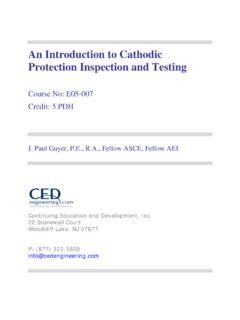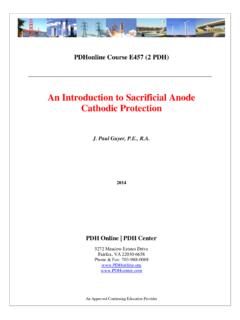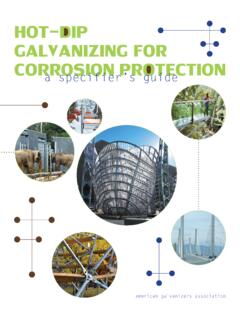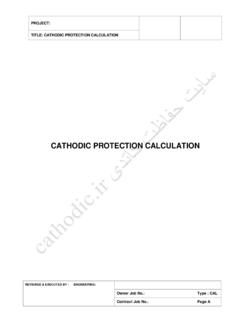Transcription of Cathodic Protection Field Installation Guide-NEW
1 Technical Memorandum No. MERL-2012-40 Guidelines for Field Installation of Corrosion Monitoring and Cathodic Protection Systems Department of the Interior Bureau of Reclamation December 2012 Mission Statements The Department of the Interior protects America s natural resources and heritage, honors our cultures and tribal communities, and supplies the energy to power our future. The mission of the Bureau of Reclamation is to manage, develop, and protect water and related resources in an environmentally and economically sound manner in the interest of the American public. Technical Memorandum No. MERL-2012-40 Guidelines for Field Installation of Corrosion Monitoring and Cathodic Protection Systems Department of the Interior Bureau of Reclamation December 2012 REVISIONS Date Description Prepared Checked Technical Approval PeerReview BUREAU OF RECLAMATION Technical Service Center, Denver, Colorado Materials Engineering and Research Lab Group, 86-68180 Technical Memorandum No.
2 MERL-2012-40 Guidelines for Field Installation of Corrosion Monitoring and Cathodic Protection Systems 8/2 r--------Mfed: Daryl A. Little Date "Materials Engineer, Materials Engineering and Research Lab Group, 86-68180 Z- Che1648: Jessica D. Tor Date Materials Engineer, Mats Engineering and Research Lab Group, 86-68180 Editorial Approval: Teri Manross Date Technical Writer-E 'tor, Client Support and Technical Presentations Office, 86-68010 ( Technic oval: Lee E. Sears Date Material ngineer, Materials Engineering and Research Lab Group, 86-68180 ///7 -Peer Review: William F. Kepler, Date Civil Engineer, Materials Engineering and Research Lab Group, 86-68180 Contents Page Chapter I: Corrosion Monitoring and Cathodic Protection Systems .. 1 Terminology .. 1 Role of Contracting Officer s 3 Reference 3 ASTM International.)
3 3 Bureau of Reclamation .. 3 National Electrical Manufacturer s Association .. 4 Chapter II: Components ..5 Common System Components .. 5 Cable .. 5 Metallurgical Welds and Bitumastic Material .. 6 Test 7 Anode Junction Boxes .. 8 8 Variable Resistors .. 9 Protective Barriers .. 10 Permanent Reference Electrodes .. 10 Insulated Joint Flange Kit .. 12 Casing Isolation 14 Dielectric Barrier Material .. 15 Warning 15 16 16 Galvanic Anode Systems .. 16 Anodes .. 16 16 Submerged .. 17 Impressed current Systems .. 18 Anodes .. 18 18 Submerged .. 19 Rectifiers .. 20 Pea Gravel .. 21 Vent 21 Carbonaceous Backfill .. 22 Anode Centralizing Devices .. 24 Grounding Rod and Cable .. 24 Rectifier Protective Barriers .. 24 i Contents (continued) Page Chapter III: General Installation .
4 25 Cable .. 25 Inspection for Quality Control .. 25 Exothermic Metallurgical Bonds .. 25 Electrical Continuity Joint (Jumper) Bonds .. 27 Structure Cables .. 29 Buried Applications .. 29 Cable 30 Electrical Isolation (Insulation) .. 31 General .. 31 Isolation Joint Flange 31 31 33 Casing Isolation .. 34 34 36 Test Stations and Junction Boxes .. 36 36 Corrosion Monitoring .. 37 Isolation Joints .. 39 Casings .. 41 Foreign Line Crossings .. 44 Galvanic Anode(s) .. 46 50 Triangular 50 Rectangular Barriers .. 50 Galvanic Anode Systems .. 53 Buried Anodes .. 53 Submerged Anodes .. 53 General .. 53 Suspended .. 53 Surface Mounted .. 57 Impressed current Systems .. 58 Rectifiers .. 58 Anode Junction Boxes .. 58 59 Shallow Bed .. 59 Deepwell 60 Submerged.
5 64 Wire Anodes .. 64 Flush Mounted .. 66 ii Contents (continued) Page Permanent Reference Electrodes .. 68 68 Submerged .. 69 69 Surface Mounted .. 70 Chapter 4: Startup and 71 Safety .. 71 Test Equipment .. 72 74 Pre-energizing .. 74 Energizing and Testing Systems .. 75 First Test Cycle .. 75 Second and Subsequent Testing 76 Appendix: Galvanic CP System Checklist and Impressed current CP System Checklist Figures Page 1 Stranded copper cable with HMWPE insulation (left) and a combination of HMWPE and Halar insulation (right) for chloride environments ..6 2 Metallurgical weld and bitumastic materials for attaching cables to 3 Big Fink type test station showing the components: (a) cap, test board, and PVC post; and (b) and (c) completed test stations..7 4 Anode junction boxes with individual shunts and variable resistors.
6 8 5 Rectifier shunt for determining current output. Shunt has a rating of 50 amperes/50 millivolts..9 6 Various types of available anode shunts: (a) Cott shunts are color coded for rating, with ratings of ohm (red), ohm (yellow), and ohm (orange)..9 7 Variable resistors for controlling galvanic and impressed current anode output: (a) slide resistor, and (b) and (c) dial type resistors..10 8 (a) Buried copper/copper sulfate, permanent reference electrode schematic, and (b) finished product ..12 9 (a) Through-wall, and (b) wall attached submerged permanent reference electrodes ..12 iii Figures (continued) Page 10 Schematic of type E isolation flange kit, showing the various components for two-sided isolation ..13 11 Schematic of type F isolation flange kit, showing the various components for single-sided isolation.
7 14 12 Casing isolation kit for metallic pipelines ..15 13 Warning tape used for marking location of CP cables ..15 14 Conduit for mounting submerged anodes such as rod and wire anodes ..16 15 Bare and bagged galvanic anodes ..17 16 Galvanic anodes for use on submerged structures ..18 17 (a) Graphite impressed current anode, and (b) HSCI impressed current 18 Linear anode of conductive-polymer coated copper, surrounded by high conductivity coke breeze, and held in place by a porous, woven, acid-resistant jacket..19 19 Examples of impressed current anodes include: (a) disk, (b) wire, pencil, and mesh; (c) stick or rod; and (d) through-wall probe electrodes ..20 20 Rectifiers used for impressed current CP systems, showing: (a) galvanized enclosure, and (b) manual taps for adjusting the 21 (a) Vent pipe with vertical and transverse slots for deep well anode beds, and (b) circled area blown up to show vertical slot cut in the 22 (a) Bag of petroleum coke backfill used for impressed current anode beds, and (b) spherical grained petroleum coke structure.
8 23 23 Example of device for centering anodes in deep well anode beds ..24 24 Schematic diagrams show the proper procedure for metallurgically bonding cables to metallic structures ..26 25 Schematic shows jumper bond Installation for: (a) a flanged joint (nonisolating), (b) a push-on joint, and (c) a flexible coupling (multiple component coupling)..28 26 Schematic shows jumper bond Installation for Victaulic 27 Schematic shows jumper bond Installation for PVC to steel fitting..28 28 Examples of jumper bonds for various pipe situations: (a) The mortar coating was removed at the joint to attach the jumper bond; (b) jumpers were installed on the pipe across the various joints, and the weld nuggets were covered with bitumastic molded cap (Handy Cap) prior to burial; and (c) bonds were installed across the expansion joint on an outlet works pipe, and the weld nuggets were coated with a bitumastic coating.
9 29 iv 29 Schematic for Installation of buried cables ..30 30 Installation of warning tape in a cable trench..30 31 Schematic for identifying and labeling all cables terminating in test stations, junction boxes, and rectifiers..31 32 Schematic shows isolation bolt Installation for isolation flange kit..32 33 Schematic shows bolt tightening sequence to provide even sealing pressure on a flange gasket..32 34 Test instruments for ensuring proper Installation and operation of isolation (insulation) joints flange kits: (a) Model 601 is for testing aboveground joints, and (b) Model 702 is for testing joints underground ..34 35 (a) Casing Installation , including spacers and end seals; and (b) casing isolators installed on a coated steel pipe ..35 36 Drawing of test station Installation for corrosion monitoring: (a) plan view of test station, and (b) close-up view of the test board.
10 38 37 Drawing of test station Installation for isolation joint: (a) plan view of test station, and (b) close-up view of the test board ..40 38 Drawing of test station Installation for a casing: (a) plan view of test station, and (b) close-up view of the test board ..42 39 Drawing of test station Installation for a casing with galvanic anode: (a) plan view of test station, and (b) close-up view of the test board ..43 40 Drawing of test station Installation for a foreign line crossing: (a) plan view of test station, and (b) close-up view of the test board ..45 41 Drawing of test station Installation for a single galvanic anode: (a) plan view of test station, and (b) close-up view of the test board ..47 42 Drawing of test station Installation for multiple galvanic anodes: (a) plan view of test station, and (b) close-up view of the test board.













